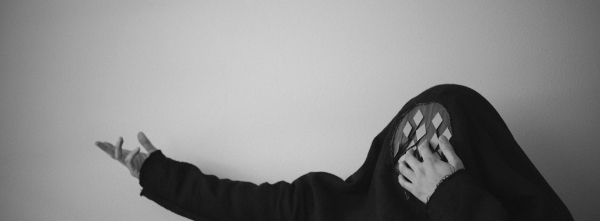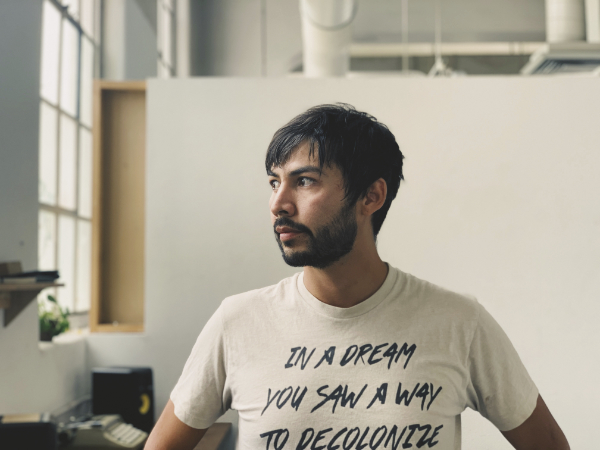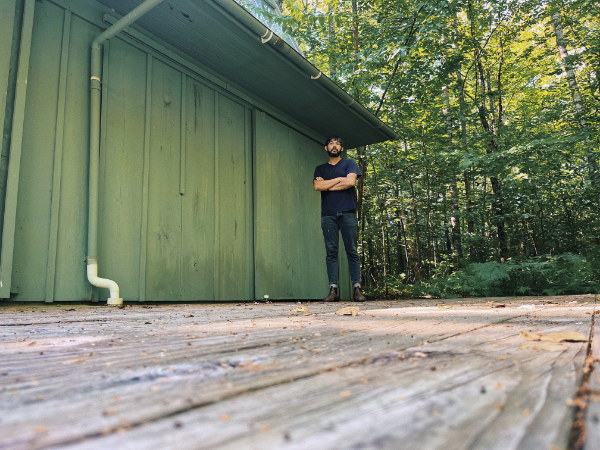Dylan McLaughlin: The Alchemy of Art and Science
By Jason Asenap
A drone glides across an empty riverbed, then transitions to a seemingly endless double line of tanker cars transporting oil on train tracks in the video art piece, In Transition Is the Most Honest. Another drone flies downward from atop a mountain overlooking Questa, near Taos Pueblo, in the video, In So We Sing the Land. In this piece, the drone follows erosion lines down a mountain from a point of view no human being could naturally see; aerial footage of the aftermath of mining from the top of the mountain downward. In yet another drone scene, we glide along the top of the Rio Grande in Albuquerque, surveying the drying ancient river that has carried water southward for innumerable generations.
Sound and video artist Dylan McLaughlin (Diné) views the world through a different lens. He zooms out and offers us a wide shot, providing images that we may not have thought to see. In his concern for the earth and how humans affect the land, he fuses his love of art and ecology, presenting a new way of seeing and experiencing the world.
The common thread that runs through McLaughlin’s work is his focus on the land, water, and the effect of extractive industries on ecosystems. As a multimedia artist, he uses sculpture, textiles, electronics, and instruments he builds and performs with to explore these conversations. McLaughlin uses his family’s legacy and knowledge of silversmith work to create musical instruments, fashioning them out of copper and nickel while using guitar effects pedals and synthesizers for sonic effects. McLaughlin describes his work in the moment as “Looking at threatened ecosystems, places that have high levels of soil toxicity, contamination from uranium sites, looking at rivers that have been impacted by a lot of diversion projects and most currently, looking at a lot of species die-off.”

McLaughlin was influenced by heavy metal and experimental noise music growing up in Kayenta, Arizona, in the Navajo Nation. Later, in Albuquerque, he became immersed in the noise music community, attending shows and working alongside musicians and performers (and later collaborators) such as Antonia Montoya, Marisa Demarco, and Diné artist Ryan Dennison. Originally a video artist, McLaughlin became interested in performance art in Brooklyn, where he collaborated with musicians and dancers. “Over the years I started building my own performance practice, where I was the one performing,” McLaughlin says. He wants his art to be felt and experienced.
McLaughlin has recently been interviewing for tenure-track teaching jobs around the West. He earned his undergraduate degree at the Institute of American Indian Arts (IAIA) in Santa Fe, and his graduate degree at the University of New Mexico in Albuquerque. He currently teaches in the low-residency studio arts MFA program at IAIA while living in Austin as a post-doctoral fellow at the University of Texas. At just thirty-four, McLaughlin’s CV yields an extensive number of accomplishments: artist residencies spanning the globe from Italy to Croatia, a Native Arts and Culture LIFT grant alongside a New Mexico Fulcrum grant in 2022, and exhibitions and performances from New York to the Netherlands. McLaughlin was described to me as an emerging artist, but I’m hard-pressed to find that his CV is that of an emerging artist. Next up for McLaughlin is a new artist residency in New Mexico.
Lincoln is the newest location for the 2024 New Mexico Arts (NMA) Artist-in-Residence program. The historic site in southern New Mexico chose two artists to host consecutively, beginning with Marcus Xavier Chormicle, who will be followed by McLaughlin. Chormicle (Agua Caliente Band of Cahuilla Indians/Chicano) is a Las Cruces-based artist. McLaughlin, currently splits his time between Texas and Brooklyn. Both artists bring their special brand of Indigenous contemporary art to the small historic community of Lincoln.
The site has seventeen structures, two museums, and is the most visited of all the historic sites in New Mexico. As a resident of New Mexico for nearly twenty years, I had never heard of Lincoln, so it was with great interest that I learned that President Rutherford B. Hayes once called Lincoln’s main street, “the most dangerous street in America.” Old West icons Billy the Kid and Pat Garrett once walked (or rode) these streets; it was the location of the Kid’s last infamous escape from jail before he was taken down by Sheriff Garrett further up at Fort Sumner.
Heck of a place to stick a couple of contemporary Indigenous artists, eh?
“This is only the second year it’s taken place, the first year being at Bosque Redondo Historic Site,” says Olivia Ortiz (Chicana/Mescalero Apache) of the NMA Artist-in-Residence program in Lincoln. Ortiz is the Art in Public Places program project coordinator for New Mexico Arts. The residency is a work in progress, with perhaps the most intriguing part being that the residencies change locations each year.
“We are looking to last year to see what can be improved but also getting to know this new site at Lincoln and fleshing out what we want the program to be.” The nationwide call for the residency prioritized artists who could connect to the site and create compelling work inspired by the location. Both Chormicle and McLaughlin have strong New Mexican ties and their project ideas spoke to the committee. It also helps that they are familiar with the landscape and probably won’t experience too much culture shock; the location in Lincoln is quite rural. The closest cities are Albuquerque—three hours north—and Las Cruces, two and half hours south. “Not great Wi-Fi,” Ortiz mentions.

Lincoln was chosen this year for the residency because, “from the sites that were available this year, this one was the most fit to be ready to live in and to host someone,” says Ortiz. It’s a pragmatic approach to an artist residency but with the wealth of beautiful locations and historic sites in the state, there’s likely not a “wrong” place to host artists.
The Lincoln location for McLaughlin as a Diné artist is filled with juxtapositions. On his mind is Bosque Redondo—roughly two hours northeast of Lincoln, where the Diné people were forcibly relocated more than three hundred miles from their homelands and several hundred died along the way.
“When I think of that part of the world I think of Bosque Redondo,” McLaughlin says. “I think if you ask any Navajo person about that area they’re going to tell you, well that’s right where Bosque Redondo is.” Typical to McLaughlin’s line of thinking, however, is that he’s also contemplating larger ideas about the area. “Lincoln is also historic grasslands, there used to be enormous bison populations in the area. I’m interested in thinking about different types of migrations, monarch butterfly migrations, I’m thinking about the ecology of this place.”
He doesn’t know anyone in the area yet, but he’s excited about the connections to be made once he arrives, “I think I’ll find those people and I think those people will find me.” he says.
McLaughlin spends most of his time working in the post-graduate program at UT Austin called Expanding Approaches to American Arts. “It’s essentially a research position that is looking at pulling together interdisciplinary researchers and scholars, including visual artists,” McLaughlin, who has been there two years, says. “A lot of the interdisciplinary and ecological research that I’m doing is able to be housed there with the idea that I would start looking to foster cross-department collaboration.”
Being in a new environment like Austin has given McLaughlin the opportunity to lean into the performance aspect of his artistic practice and he’s getting recognition for this new phase. He was invited to perform in the Fusebox Festival, a performance art festival in Austin, now in its twentieth year. McLaughlin welcomes improvisation and is excited about the evolution of his practice, “It helps to let my work change” he says.
In addition to a new emphasis on performance, McLaughlin also thinks about the presence and notable absence of Native people during his time in Texas. “There used to be a lot of Native people in the area; now it’s complicated.” He’s quick to point out that he’s not relying on the state’s mythology to influence his art and that he just sees the location as a place to meet new people and get fresh ideas. “Another artist could hypothetically arrive to Texas and be like, okay, this is my ‘Texas work,’” McLaughlin says comically.
For a New Mexican Indigenous artist away from his community, it must feel like a homecoming to return to New Mexico to create art. The six-week residency for McLaughlin began April 26 and ends June 7. Artists have a broad directive for how to use their time in residence. The only state-supported artist residency, it is open to artists working in any genre and at any stage of their careers.
“[Dylan’s] project proposal in many ways left some room for imagination, which typically a review committee might give a reason for pause, but if you’re familiar with his work it’s very multidisciplinary and I think he explores his ideas in multiple, different avenues,” Ortiz says. “We are excited to see what his final product will actually be, but more so excited to see the process he takes for the site specifically.”

Ortiz notes that the committee thought McLaughlin challenged the tri-cultural trope that exists at the Lincoln Historical Site and offers a fresh perspective of the region. “He’s typically pretty collaborative with community. That was another point of interest of us, to see how that could play out,” Ortiz says. McLaughlin will be new to the area but should have no problem building new relationships, given his history of working in other rural areas such as Standing Rock Reservation.
A notable collaboration for McLaughlin was with fellow IAIA alumni Cannupa Hanska Luger (Hidatsa, Arikara, and Lakota). “Cannupa and I were in the same graduating class, so we were good friends through college and after college we started an art collective together,” says McLaughlin. Winter Count Collective looked at Indigenous communities affected by extractive industries. Its work started at Standing Rock, which became one of the focal points for the battle over clean water in 2016. It was a site where Indigenous protestors from all over the country came together to defend the local Indigenous communities’ right to clean water.
Winter Count describes itself as a collective of multi-disciplinary artists working in film, performance, installation, sculpture, storytelling, and sound composition. The roster for Winter Count included a who’s who of notable contemporary Indigenous artists: Ginger Dunnill, Merritt Johnson, Nicholas Galanin, Demian Dinéyazhi, and Laura Ortman, in addition to McLaughlin and Hanska Luger. The collective showed installation and video work on both coasts and disbanded when McLaughlin left for grad school at UNM.
McLaughlin’s time in Albuquerque led to notable collaborations, including an exhibition about the drying of the Rio Grande titled, There Must Be Other Names for the River, with the artists Marisa Demarco and Jessica Zeglin. The exhibition was inspired by the environmental reporting of Albuquerque journalist Laura Paskus, who wrote a book about the Rio Grande and climate change called, At the Precipice.
“The three of us were in grad school together and we developed what has become a multiyear collaboration,” McLaughlin says of the ongoing exhibition. “At its core it’s an experimental music composition that is derived from historic stream flow data.” The musicians procured the data from the public United States Geological Survey site and interpreted and played the scientific data sonically.
The Rio Grande has been noticeably decreasing in water flow over the past few years, and it’s become a topic of conversation. “It’s a conversation about the cultural relevance of the Rio and the politics and the climate effects—just kind of looking at all of the conversations around the Rio and how it’s very much a lifeline that runs through New Mexico, Colorado, and Texas,” says McLaughlin.
So far, there has been a web-based installation of the work early in the pandemic, a larger exhibition in 2023 at SITE Santa Fe, and multiple performances in between—notably at the National Hispanic Cultural Center and at The University of New Mexico Art Museum. The music was performed by singers at these exhibitions, but at SITE Santa Fe, a sound installation played round-the-clock in the Railyard as a public art event.
During our conversation, McLaughlin consistently references scientific activity, things he is thinking about, the natural order of things that are upended by human beings, or things that human beings are taking for granted about the natural world—things like cottonwood trees in Albuquerque near the Rio Grande. “The cottonwood tree is seemingly a pretty abundant species in Albuquerque,” McLaughlin says, but he predicts a time in the next decade when these abundant trees will die.
“Basically, all of the cottonwood trees within Albuquerque, within the metropolitan area, were pretty much planted all around the same time.” The cottonwoods in the bosque require flooding from the Rio Grande that can no longer happen because of human settlement. “They only live up to seventy to one hundred years old. Once they reach that maturing point when they die, they’re all going to die around the same time.” McLaughlin wonders what the reaction and discussion will be when this happens. “Can you imagine Albuquerque with no cottonwood trees? It’s going to impact the city so much.”
And while his work is informed by scientific research, he’s careful not to call it scientific; rather, he uses science as a jumping off point for further discussion. “I’m looking at the research of scientists and I’m taking all of that information and I’m finding ways to synthesize it into my own work; finding ways to turn it into music or turn it into performance or turn it into sculpture,” he says. “It’s giving people entry points into these conversations so that people can have this information and can be thinking about these things.”
McLaughlin, who comes from a long line of house builders, farmers, and silversmiths, takes his role as an artist seriously. He chose art as his path because “It’s about people, it’s about storytelling, it’s about learning about the world and learning about the misunderstandings and misinterpretations and erasure and invisibility that we live with right now. There’s a lot of stories that are not being told.”

McLaughlin’s list of influences is not what you might expect for an artist. At the top of his list are NDN Collective, an organization dedicated to activism and philanthropy; and Source New Mexico, an independent publication that reports on New Mexican news and politics and highlights subjects that McLaughlin is driven to create art about, such as extractive industries. “I love the work of Source NM … all the work that is being done at Source around the Rio,” he says. “I look to a lot of journalists who are doing activism-related work or science-related work or ecology-related work.”
At Lincoln Historic Site, McLaughlin looks forward to creating in a new space. “I have no idea exactly what to expect from the time there, but I think that’s kind of the beauty of an art residency.” Recently, he’s been researching a mass die-off of migrating butterflies in Colorado.
“The Monarch butterflies are flying through Colorado and New Mexico down into Mexico,” he says. “We’re talking about habitat loss of these butterflies. We’re also talking about the loss of historical grasslands, so we’re talking also about the loss of the bison populations.” The concept of population displacement weighs on McLaughlin’s mind, and he thinks of the first NMA Artist-in-Residence location, Bosque Redondo and The Long Walk, where many of his ancestors died. “I’m looking at the intersectionality of all of these issues… I would love to tap into working with some musicians in the area and build some kind of large ensemble music piece—like I do in a lot of my work—in response to the complexity of all of these issues.”
A conversation with McLaughlin leaves the mind reeling with images of species migrations, data crunching, dead trees, and dry rivers—things I thought were the opposite of art. Mclaughlin’s approach is unapologetic; for him, these elements are perfectly natural things to synthesize and from which to create art. There’s little doubt that he will bring something special to the small village in southeast New Mexico, and the village and its surroundings will influence him in a unique way—a way only McLaughlin could think of.
—
Jason Asenap is a Comanche and Muscogee writer and filmmaker based in Albuquerque. He holds an MFA in Screenwriting from IAIA. His films have screened around the U.S. and internationally. In addition to filmmaking, Asenap writes about Indigenous contributions to film, art, and culture. He is an award-winning Indigenous film critic, including awards for his film criticism from the Native American Journalist Association in 2020 and 2022 and an award from the Los Angeles Press Club for best Visual Arts/Architecture Feature in 2024. You can find his writing in Esquire, Variety, Vox, Alta Journal, Grist, High Country News, Salon, and New Mexico Magazine.

